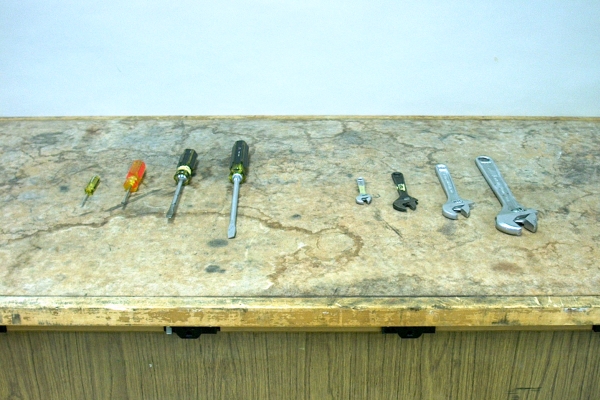

You can use different sizes of (flat-blade) screwdrivers and (adjustable) wrenches to illustrate the practical application of torque.
Torque, τ, equals r × F. Its magnitude is rF sin θ. Here, r is either the radius of the screwdriver handle or the length of the wrench from the center of the nut held between the jaws to the place on the handle where you pull (or push) on the wrench. F is the force you apply, and θ, of course, is the angle between the vectors r and F. For the screwdrivers, since you wrap your hand around the handle and turn the screwdriver, you apply the force at 90° to the radius of the handle. While it is possible to hold the wrenches at various angles, when you wrap your fingers around the wrench handle, the most natural angle at which to hold it is 90°. This, of course, maximizes the torque you can exert, and unless the nut or bolt you are trying to turn is in an awkward location, it is how you would normally apply force to the wrench handle.
As noted above, r is the radius of the screwdriver handle or the length of the wrench handle (from the center of the nut or bolt being turned to where you hold the wrench), so the larger the diameter of the screwdriver handle, or the longer the wrench handle, the greater the torque you can develop by applying a given force.
You can think of screwdrivers and wrenches as modified class one levers (see 20.03, 28.06 or 32.03 -- Lever arm). A class one lever is one in which the “load” and the “effort” are on opposite sides of the fulcrum. Here, the fulcrum is the center of the screw or nut (or whatever you are turning with the screwdriver or wrench) and, hence, the central axis of the screwdriver, assuming it is centered on the screw, or a point between the jaws of the wrench. The radius where the load is applied depends on the particular situation. First of all, if the screwdriver blade fits tightly in the slot of the screw head, the moment about the blade is the integral of all the moments from the center to the edges of the blade. If the fit is not tight, torque is transmitted only at the edges of the blade, so the moment is merely that applied at the edges, and the radius is half the width of the blade. In this case, the mechanical advantage offered by the screwdriver is the ratio of the handle radius to half the blade width (or the handle diameter to the blade width), or rhandle/rblade. The overall actual mechanical advantage, however, can depend on the dimensions of what you are turning with the screwdriver. For example, if the diameter of the screw thread is greater than the width of the screwdriver blade, then the overall mechanical advantage is reduced. If the screw thread is narrower than the blade, however, the mechanical advantage is greater. In either case it becomes rhandle/rthread.
With the wrench, the radius at which the load acts is the inner radius of whatever you are turning with the wrench, for example, the radius of the thread of a nut. If we call the distance from your hand to the center of the nut rhandle, and the radius of the thread of the nut rthread, the mechanical advantage the wrench affords is the ratio rhandle/rthread. Holding the wrench close to the jaws lowers the mechanical advantage, and holding it as close as possible to the far end of the handle maximizes the mechanical advantage.